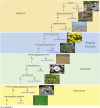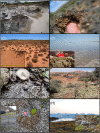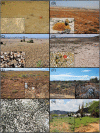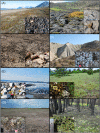What is a biocrust? A refined, contemporary definition for a broadening research community
- PMID: 35584903
- PMCID: PMC9545944
- DOI: 10.1111/brv.12862
What is a biocrust? A refined, contemporary definition for a broadening research community
Abstract
Studies of biological soil crusts (biocrusts) have proliferated over the last few decades. The biocrust literature has broadened, with more studies assessing and describing the function of a variety of biocrust communities in a broad range of biomes and habitats and across a large spectrum of disciplines, and also by the incorporation of biocrusts into global perspectives and biogeochemical models. As the number of biocrust researchers increases, along with the scope of soil communities defined as 'biocrust', it is worth asking whether we all share a clear, universal, and fully articulated definition of what constitutes a biocrust. In this review, we synthesize the literature with the views of new and experienced biocrust researchers, to provide a refined and fully elaborated definition of biocrusts. In doing so, we illustrate the ecological relevance and ecosystem services provided by them. We demonstrate that biocrusts are defined by four distinct elements: physical structure, functional characteristics, habitat, and taxonomic composition. We describe outgroups, which have some, but not all, of the characteristics necessary to be fully consistent with our definition and thus would not be considered biocrusts. We also summarize the wide variety of different types of communities that fall under our definition of biocrusts, in the process of highlighting their global distribution. Finally, we suggest the universal use of the Belnap, Büdel & Lange definition, with minor modifications: Biological soil crusts (biocrusts) result from an intimate association between soil particles and differing proportions of photoautotrophic (e.g. cyanobacteria, algae, lichens, bryophytes) and heterotrophic (e.g. bacteria, fungi, archaea) organisms, which live within, or immediately on top of, the uppermost millimetres of soil. Soil particles are aggregated through the presence and activity of these often extremotolerant biota that desiccate regularly, and the resultant living crust covers the surface of the ground as a coherent layer. With this detailed definition of biocrusts, illustrating their ecological functions and widespread distribution, we hope to stimulate interest in biocrust research and inform various stakeholders (e.g. land managers, land users) on their overall importance to ecosystem and Earth system functioning.
Keywords: biocrust; biological soil crust; climate.; definition; function; habitat; physical structure; taxonomy.
© 2022 The Authors. Biological Reviews published by John Wiley & Sons Ltd on behalf of Cambridge Philosophical Society.
Figures







Similar articles
-
The hidden network of biocrust successional stages in the High Arctic: Revealing abiotic and biotic factors shaping microbial and metazoan communities.Sci Total Environ. 2024 May 20;926:171786. doi: 10.1016/j.scitotenv.2024.171786. Epub 2024 Mar 18. Sci Total Environ. 2024. PMID: 38508248
-
Mapping biocrust distribution in China's drylands under changing climate.Sci Total Environ. 2023 Dec 20;905:167211. doi: 10.1016/j.scitotenv.2023.167211. Epub 2023 Sep 18. Sci Total Environ. 2023. PMID: 37730025
-
Biological soil crusts and how they might colonize other worlds: insights from these Brazilian ecosystem engineers.J Exp Bot. 2022 Jul 16;73(13):4362-4379. doi: 10.1093/jxb/erac162. J Exp Bot. 2022. PMID: 35522077 Review.
-
Photoautotrophic organisms control microbial abundance, diversity, and physiology in different types of biological soil crusts.ISME J. 2018 Apr;12(4):1032-1046. doi: 10.1038/s41396-018-0062-8. Epub 2018 Feb 14. ISME J. 2018. PMID: 29445133 Free PMC article.
-
Enhancing Soil Health Through Biocrusts: A Microbial Ecosystem Approach for Degradation Control and Restoration.Microb Ecol. 2025 Feb 22;88(1):8. doi: 10.1007/s00248-025-02504-5. Microb Ecol. 2025. PMID: 39985718 Free PMC article. Review.
Cited by
-
Balanced biogeographic and local environmental effects determine the patterns of microbial diversity in biocrusts at multi-scales.Front Microbiol. 2023 Nov 9;14:1284864. doi: 10.3389/fmicb.2023.1284864. eCollection 2023. Front Microbiol. 2023. PMID: 38029206 Free PMC article.
-
Desiccated Cyanobacteria Serve As Efficient Plasmid DNA Carriers in Space Flight.ACS Synth Biol. 2024 Sep 20;13(9):2733-2741. doi: 10.1021/acssynbio.3c00672. Epub 2024 Aug 16. ACS Synth Biol. 2024. PMID: 39150229 Free PMC article.
-
Heavy metal pollution simplifies microbial networks and enhances modularity during tailings primary succession: divergent assembly dynamics for bacterial and fungal communities.Front Microbiol. 2025 Jul 18;16:1566627. doi: 10.3389/fmicb.2025.1566627. eCollection 2025. Front Microbiol. 2025. PMID: 40756216 Free PMC article.
-
Habitat suitability of biocrust communities in a cold desert ecosystem.Ecol Evol. 2024 Jun 28;14(7):e11649. doi: 10.1002/ece3.11649. eCollection 2024 Jul. Ecol Evol. 2024. PMID: 38952663 Free PMC article.
-
Spatiotemporal Dynamics of Bacterial Community Assembly and Co-Occurrence Patterns in Biological Soil Crusts of Desert Ecosystems.Microorganisms. 2025 Feb 18;13(2):446. doi: 10.3390/microorganisms13020446. Microorganisms. 2025. PMID: 40005811 Free PMC article.
References
-
- Anderson, D. C. , Harper, K. T. & Holmgren, R. C. (1982). Factors influencing development of cryptogamic soil crusts in Utah deserts. Journal of Range Management 35, 180–185.
-
- Arnalds, O. (2015). The Soils of Iceland. Springer, Heidelberg, Berlin.
-
- Barger, N. N. , Herrick, J. E. , van Zee, J. & Belnap, J. (2006). Impacts of biological soil crust disturbance and composition on C and N loss from water erosion. Biogeochemistry 77, 247–263.
-
- Barger, N. N. , Weber, B. , Garcia‐Pichel, F. , Zaady, E. & Belnap, J. (2016). Patterns and controls on nitrogen cycling of biological soil crusts. In Biological Soil Crusts: An Organizing Principle in Drylands (eds Weber B., Büdel B. and Belnap J.), pp. 257–285. Springer, Cham.
Publication types
MeSH terms
Substances
LinkOut - more resources
Full Text Sources
Other Literature Sources
Research Materials

